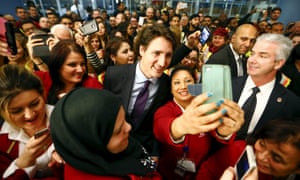 Canada’s prime minister is a self-proclaimed feminist. Two years ago, Justin Trudeau’s appointment of the country’s first gender-equal cabinet made headlines worldwide. Recently, his government has released what has been called the “first feminist foreign aid policy”.
Canada’s prime minister is a self-proclaimed feminist. Two years ago, Justin Trudeau’s appointment of the country’s first gender-equal cabinet made headlines worldwide. Recently, his government has released what has been called the “first feminist foreign aid policy”.
But now Canada’s own record on gender equality has been called into question by a perhaps unlikely source. The McKinsey Global Institute, a research arm of the corporate consultancy giant, has declared that the country’s workplaces have a “substantial gender gap”.
In a 124-page report, it describes tackling enduring gender inequalities at work as “a considerable economic opportunity” for Canada, which it predicts could add upwards of $150bn to the country’s GDP by 2026. McKinsey’s Tiffany Vogel told CBC that gender equality is “not just a moral imperative [and] not just the right thing to do – it’s good business practice”.
Recent data from Canada’s national statistics agency shows that for every $1 a man makes, on average a woman makes $0.74 – in part because women are disproportionately represented in low-wage jobs, including in fast food and hotel work.
A study of Ontario retail workers – most of whom are women – found that men earn more across all job categories, and are more likely to be offered full-time jobs or employed as managers.
The gender issue pervades all levels of business: corporate boards are dominated by men, and 95% of CEOs are male. McKinsey surveyed 69 of Canada’s largest companies and found that fewer women were being promoted. Among these companies, women make up 45% of entry-level workers, 25% of vice-presidents and 15% of CEOs.
“The gender pay gap persists in all types of occupations, even when women are in higher-paying jobs,” said Trish Hennessy, a director at the Canadian Centre for Policy Alternatives (CCPA) thinktank. Pay gaps are particularly pronounced for immigrants and indigenous women, she added.
Hennessy said one way to close these gaps is to “revalue the caring work that women do” – referring to unpaid work at home, caring for family members, and paid work including in early childhood education. “Unionisation helps, too,” she said. “The gender pay gap is lower in unionised jobs – unions can be a great equaliser.”
Last year, Canada also fell down in the World Economic Forum’s global gender equality rankings, to 35th place. In 1995, it was in first placeArmine Yalnizyan, a Canadian economist and business commentator, said that while gender inequality at work is a national problem, “there are huge variations across the country”. For instance, she said the Saskatchewan province appears more equal than neighbouring Alberta, which has larger pay gaps.
These gaps are falling among young people, she said, “but they’re nowhere near closed. It’s people that don’t have more than high-school [education] that see the biggest wage gap between women and men.”
Yalnizyan said higher minimum wages “would affect way more women than men, and would begin to compress wages”. She also described increasing access to childcare and early childhood education as a “virtuous cycle”, enabling more women to work while also creating jobs.
The McKinsey report says tackling these gender inequalities could lead to “re-energising Canada’s economy and its businesses”. It says GDP growth has slowed to approximately 2% a year, and that “a significant part of the solution is for Canada to tap into the vast, unrealised potential of women”.
No comments:
Post a Comment